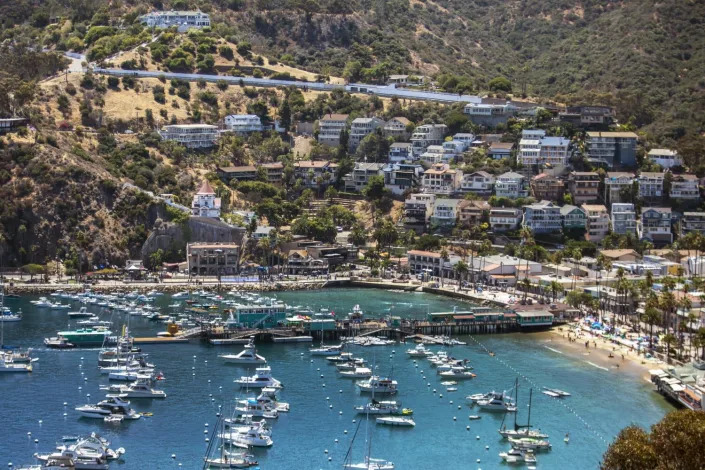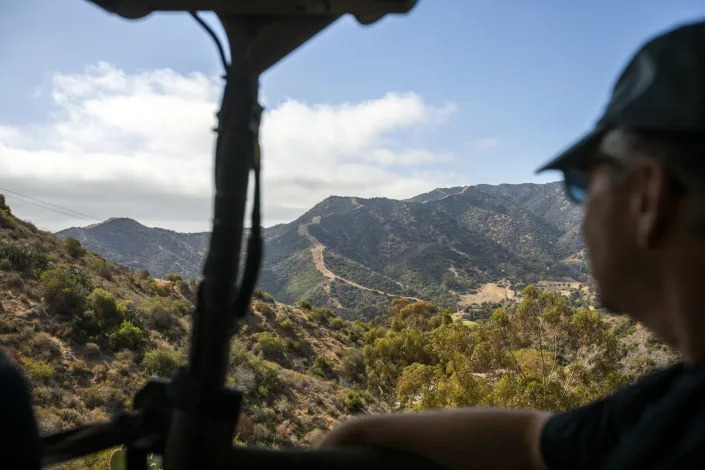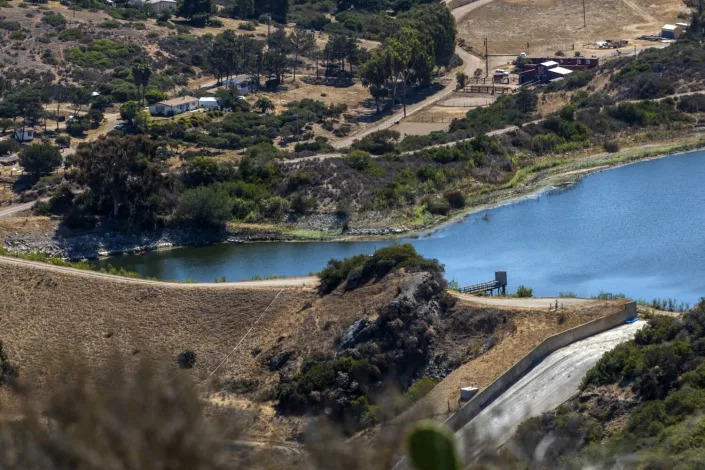Los Angeles Times
Saltwater toilets, desperate wildlife: Water-starved Catalina Island battles against drought

Island-dweller Lori Snell grimaced as she tallied her bill recently at the Avalon Laundry — nearly $50 for three large loads.
“It’s always an adventure to live in Catalina,” said Snell, 64. “It’s a joy, it’s a paradise, it’s a challenge.”
For Snell and Santa Catalina Island’s other 4,000 full-time residents, water is a bit of an obsession. When you live an hourlong ferry ride from Long Beach, a gallon of the stuff can cost six times more than it does “over town” — the islanders’ term for the mainland.
That preoccupation with water has now become critical as severe drought grips California and its Channel Islands — a rugged, eight-isle archipelago that hosts several human outposts and a handful of species that exist nowhere else on Earth.
But although some of the island’s wildlife is struggling for survival, conditions for humans are a little different today than in droughts past, due largely to a desalination plant that opened in Avalon in 2016. The plant today provides about 40% of Avalon’s drinking water.
“Over town, you’re not affected by drought as much as you are here,” said Snell, a former resident of Encino. “All the locals and businesses are very aware. Our ability to live here depends on us having fresh water.”

Many Avalon residents still have vivid memories of the state’s last punishing drought, which forced them into severe Stage 3 water restrictions at the end of 2016.
Things got so bad that even some fine-dining restaurants switched to paper plates to avoid running dishwashers, and hotels ferried their linens to the mainland for laundering in an effort to cut costs and conserve tight supplies, several locals said.
But desalination has helped keep them out of similarly severe water restrictions so far this year, according to Ronald Hite, senior manager of Catalina Island for Southern California Edison, the island’s water provider.
“We run desal 100% of the time and rely on it, and then supplement with groundwater,” Hite said. “That’s bought us a year, and taken us really from the front of the line — where we were last time, going into drought restrictions and rationing — to the back of the line, which is fantastic.”

Indeed, although most of mainland Los Angeles moved into Stage 3 restrictions at the start of June, Avalon in July crept into only Stage 1, even as its reservoir dropped about 100 acre-feet in the last three months. Hite said it’s a remarkable feat for an island that has no access to state or federal water supplies, and which for decades relied primarily on its reservoir to supply full-time residents and roughly 1 million visitors each year.
“This is different this time — we’re actually in a much better spot than our peers elsewhere,” he said. “And the main driver of that is that we are using every drop of our drought-resistant resources that we possibly can. … We might be facing mandatory rationing right now had we operated the system like we used to.”
That’s not to say water is taken for granted on Catalina, where conservation has largely become a way of life. According to Hite, residents use an average of 57 gallons per day — about half of the residential average in the area served by the Los Angeles Department of Water and Power. What’s more, there are very few lawns that require water, and most homes have saltwater toilets that keep them from flushing freshwater down the drain.
Gregg Miller, who owns Avalon’s Hotel Metropole and Market Place, which includes several restaurants and the laundromat, said he’s spent the last four years converting most of the hotel’s bathtubs into showers in order to save water. He also got rid of all their hot tubs.
“It’s such an ongoing situation,” Miller said of drought. “It never gets quite resolved, so you’re always really doing things that you hope will save some water. It’s a challenge.”

And although he said it can be “hard to tell people paying $300 a night, ‘Don’t take a long shower,’ ” the new desalination plant has helped give everyone some breathing room.
“To some degree, the desal plant has taken a little bit of the pressure off,” Miller said. “Because unlike most other places, we don’t have any secondary source, another municipal district that could lend us water or share water with us. We have only what we have in our reservoirs and a few small wells.”
The message hasn’t necessarily registered with all of the island’s visitors, including the thousands of tourists who arrive each week via cruise ships and those who take the ferry from L.A., Long Beach and Orange County.
Phil and Cheryl Gaston, who were visiting from Georgia, said they were aware of the drought conditions plaguing the West but that it hadn’t really factored into their plans to visit the island.
“If I had been planning a vacation in Lake Mead, though, I wouldn’t go,” said Phil Gaston, 66.


Alex Romero, a 40-year resident of Avalon who runs and owns the burger-and-dog outpost Coney Island West, said that “it would be nice if [tourists] would be more conscious — their long showers really kill us.” But he also added that visitors are the lifeblood of the island and essential to the residents’ way of life. “They’re what keep us going.”
Romero recently converted the restaurant’s three-compartment sink into two compartments to help save water, he said. And instead of hosing down the patio nightly, he’s doing it once a week and using a mop the rest of the time.
“The reservoir and desal help, but we need rain this year for sure,” he said. “If not, it will get a lot worse.”
Desalination is also not without controversy. In May, plans for the massive Poseidon plant in Huntington Beach were rejected by the California Coastal Commission due to concerns about high costs, ecological hazards and other significant hurdles. The desalination process, which typically includes the discharge of hypersaline brine back into the ocean, has been criticized for negatively affecting marine life near facilities, as well as high energy consumption.
Hite, the Edison manager, said many of those effects have been mitigated at the Avalon plant because of its relatively small scale. Although the Poseidon plant would have produced up to 50 million gallons of drinking water a day, the facility in Avalon produces about 240,000.

“We’ve got a couple things going for us here in terms of desal production in that number one, we are surrounded by water so we have easy access to it, and number two, we’re relatively small scale,” he said. “It’s much less of an impact for someone like us than for, say, a giant plant such as those that have been proposed recently.”
According to the most recent monitoring report submitted to state regulators, salinity levels from the plant are relatively low, around 50 parts per thousand at the discharge point and 30 to 35 parts per thousand at various depths and distances from the facility. Average ocean salinity, broadly speaking, is about 35 parts per thousand.
Hite said the reverse-osmosis plant, which is diesel-powered, also uses the high-pressure reject water to help turn its pump, enabling it to use a smaller motor and reduce electrical consumption. Edison is currently seeking a grant for a new deepwater well that would allow it to bring an older desalination facility on the island, built in the 1990s, back online, he said.
Yoram Cohen, a desalination expert and professor of chemical and biomolecular engineering at UCLA who is not affiliated with the Avalon plant, said size can be a factor when it comes to the impact of the brine.
“If you discharge 20, 25 million gallons a day, that’s a lot more than 200,000 gallons a day,” he said, “so the impact on the environment, the local impact, is going to be very different. It may be easier to disperse a small volume, or a small volumetric flow, than it is a huge one.”


Cohen said recent studies from Australia, Israel, Singapore, Saudi Arabia and other places using desalination have also shown that discharge “should not have an adverse impact” if it is done properly. But although desalination can be a helpful tool — especially for areas near the coast — it shouldn’t be the only source of supplies, he said.
“Desal alone is not going to solve the problem, but it’s an added component of our water portfolio,” Cohen said. “At the end of the day, I think that we have to keep our water portfolio diversified, just like you would keep your money invested in multiple places. You want to be safe, right? You don’t put your money in one investment.”
There are other challenges too. Many residents are now fighting a proposed rate hike by Edison that they say will make their already-pricey water even more expensive. The agency said the increase will help recoup some losses from the last drought and keep the systems running.
“Desal is not an inexpensive operation,” Avalon Mayor Anni Marshall acknowledged. She said the island’s small number of ratepayers also drive up the costs because there are fewer people to share the expense. “But I think the trade-off is, we love living here and we’re willing to sacrifice as much as we can — or as much as we have to.”

Marshall said she wants the island to work toward new groundwater capture and water recycling projects in the near future. But she also noted that because most homes use saltwater toilets and don’t have frontyards, the significant 50% savings residents achieved during the last drought were hard-won.
“That large reduction we did was basically personal consumption — it was in our showers, washing dishes and that kind of thing,” she said.
The mindset is apparent all around the town, where beachgoers this week rinsed off under saltwater showers and restaurants declined to provide tap water, offering only bottles. One woman was spotted cleaning the sidewalk with a bucket and a cup, carefully doling out one splash at a time. For many, including Marshall, it’s a success story.
“It’s amazing,” she said. “The situation we’re in now is nothing compared to what it was in the previous drought.”

But although desalination is keeping Catalina’s humans supplied with potable water, it can’t do quite as much to help the island’s flora and fauna amid worsening drought.
The famed Catalina Island fox, as well as the island’s non-native deer and bison, are “suffering mightily” due to the lack of moisture, which is tied closely to their food supply, according to Deni Porej, senior conservation director with the Catalina Island Conservancy. Lately, he said, deer have been appearing on the island’s golf course in the evenings, when they know the sprinklers will turn on and provide them with a spot of relief.
What’s more, a combination of dry conditions, deer predation and pollination problems is threatening the island’s ancient ironwood trees, of which there are only about 120 left.
“Groundwater is hugely important to us, because a lot of the plants that we have here have very deep roots, and they tap into the groundwater,” Porej said, noting that for the ironwoods, “the issue of groundwater is a matter of life and death.”

“It’s a weird feeling when you’re standing in the grove and you’re looking at basically a species dying out. It’s kind of a gut punch,” he said.
Porej said he hoped to see island officials come together to develop a more comprehensive groundwater management plan, but he also credited the desalination plant with improving some of Catalina’s conditions.
“It’s helping, but it’s not the ultimate solution, because there’s always a need for more,” he said. “We will always be looking for opportunities to have more water on the island. That’s the limiting factor to our ecosystem, it’s the limiting factor to growth. Like many parts of California, it’s about gold and water.”
